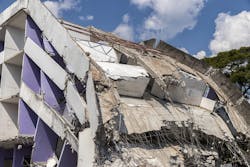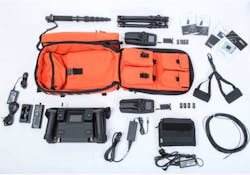From the battlefield to the disaster zone
While much of the focus of physical security today is centered on thwarting malicious actors from causing harm to people or property, the biggest threats facing the safety of both public and private sector organizations largely remain those presented by Mother Nature. From earthquakes and tsunamis to hurricanes, fires and floods, natural disasters can inflict catastrophic losses at a moment’s notice.
However, while these events are hard to predict and may inevitably result in the loss of life, there are a variety of tools coming onto the market that can help rescue workers find and save more people than would have been possible just a decade ago. A company offering such a solution is Israeli-based Camero-Tech, a provider of micropower radar solutions based on ultra-wideband (UWB) radar imaging technology.
Founded in 2004, the company, which provides what it calls “see-through wall imaging” solutions, recently began offering this technology in a compact Search & Rescue kit to end users around the world. According to Camero-Tech CEO Amir Beeri, the company’s technology, which was originally developed for the military, has been tailored to address a variety of applications through the years, from short range operations up to 20 meters (65.6 feet) to longer range use cases of up more than 100 meters (328 feet).
The new Search & Rescue kits, for example, were developed as a short-range solution and include the company’s XAVER 100 and XAVER 400 detectors along with XAVERNET, a ToughPad tablet that enables end users to control and monitor up to four XAVER systems remotely.
“Generally, in search and rescue, we are targeting short range, sometimes very short range. If we are talking about a collapsed building, for example, we would like to penetrate one, two or three layers of debris and actually detect people that are trapped in voids in the collapsed structure,” Beeri explains. “The idea here is first, to detect life in a disaster scenario and then to locate the exact point where the victim is, and to make it easier to reach and save a life. As time is critical in such scenarios, the need to detect as soon as possible, sometimes in large areas, is really critical and we believe this tool is going to be a real gamechanger.”
Aside from collapsed structures, Beeri says the technology can also be used in a wide range of other disasters, including fires.
“Because we are using radio waves, it is completely transparent – not only to smoke but also to the fire itself,” he adds. “Firefighters are using IR cameras, but this is to detect victims through fog and smoke but not through fire. The fire itself is actually so bright for the IR cameras that they cannot see through it and, of course, it cannot see through walls. The idea here is to work in a safe place for the firefighters, for the rescue teams out of the dangerous place to detect and locate the victims.”
Currently, in the aforementioned scenarios, Beeri says that rescuers must rely on specially trained canines to find victims within rubble or perhaps, if they are fortunate enough, they can use borescopes or an array of microphones to see or hear sounds of life through layers of debris. But even with these tools, pinpointing the exact location of a survivor or the potential unseen dangers posed by a possible extraction is difficult.
“By using radio waves, we can detect reflection from live objects behind these layers of debris and to scan the area. It can be done by one device just going through or by a few systems that are scanning the area while using a wireless remote to see more than one device,” he says. “XAVERNET can control and monitor up to four systems simultaneously, so you can monitor quite a big area and just scan and see if you have any signs of life below the layers and then to locate exactly and plan out to reach the survivor.
“Using this kit can really help not only detect and locate the victim, but also during the rescue itself when you reach the person, not to hurt them,” Beeri continues. “After you detect the person, it can be quite dangerous to take them out alive because everything is unstable, and you have to be very careful. So, with the system, we can see all the time, in real time, the object and we can detect also the static reflection or the layers – we can see the void itself – so we can take care that we are not doing something that will kill them while we attempt a rescue.”
According to Beeri, the Search & Rescue kits have already been used in locations around the world and are currently available for purchase.
Joel Griffin is the Editor of SecurityInfoWatch.com and a veteran security journalist. You can reach him at [email protected].




